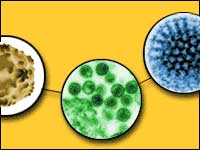Life Sciences and Chemistry
Articles and reports from the Life Sciences and chemistry area deal with applied and basic research into modern biology, chemistry and human medicine.
Valuable information can be found on a range of life sciences fields including bacteriology, biochemistry, bionics, bioinformatics, biophysics, biotechnology, genetics, geobotany, human biology, marine biology, microbiology, molecular biology, cellular biology, zoology, bioinorganic chemistry, microchemistry and environmental chemistry.

After a 40-year search, a hormone controlling iron metabolism in mammals is finally identified
Iron is vital for cells, because it catalyzes key enzyme reactions; it is also crucial for respiration, fixing atmospheric oxygen to hemoglobin in red blood cells. Iron deficiency can lead to severe anemia, with inadequate tissue oxygenation. An excess of iron is also toxic, as it facilitates the generation of free radicals that can attack the liver, heart and pancreas. This is the case in hereditary hemochromatosis, a genetic disorder which, in 80% of cases, is linked to a point mutation in the Hfe-

Diverse Viruses Show Signs of Common Ancestry
The viruses that cause diseases as varied as AIDS, hepatitis and West Nile Virus may actually have more in common than was previously thought, new research reveals. According to a study that will appear in the March issue of the journal Molecular Cell, three major groups of viruses use similar mechanisms to replicate their genetic information after they have infiltrated the cells of a host.
There are six broad classes of viruses, each thought to represent a major evolutionary lineage. M

Mouse Study Suggests Anxiety Disorders Take Root in Infancy
The absence of a key signaling protein in the brain during infancy could lead to anxiety disorders later in life, scientists say. According to findings published today in the journal Nature, mice lacking the receptor protein for the chemical messenger serotonin just after birth exhibit abnormal anxiety as adults.
Researchers have known for some time that mice genetically engineered to lack the receptor for serotonin, a neurotransmitter, show anxiety-like behavior. But the new results go one

Bacteria dye jeans
Biotech bugs turn indigo blue in a green way.
Jeans dyed blue by bacteria may soon be swaggering down the streets. Researchers have genetically modified bugs to churn out the indigo pigment used to stain denim. The process could be a greener rival to chemical indigo production.
Originally extracted from plants, indigo dye is now made from coal or oil, with potentially toxic by-products. Bacteria have previously been adapted as alternative indigo manufacturers, but a trace by-

The hidden danger in used tyres
The international used tyre trade is bringing unwanted visitors to Europe – exotic mosquitoes. Species such as the Asian ‘Tiger Mosquito’ are able to survive in temperate climates, spread diseases (such as dengue and West Nile virus, among others) and may be poised to take Britain by surprise, unless monitoring systems are put in place.
Tiger mosquitoes lay their eggs around places that are prone to flooding. Their eggs can survive long periods of drought and, when a pool forms, the larvae

The rule of the game
Every kilogram of predator needs a fixed amount of prey.
Every kilogram of meat-eating mammal needs 111 kilograms of prey to sustain it, say two ecologists. The rule holds from weasels to bears.
With many species of carnivore endangered, the discovery could help conservationists work out how to maintain a species’ resource base.
Chris Carbone, of the Institute of Zoology, London, and John Gittleman, of the University of Virginia, found the rule when they compare